Parameshvara Dasa was completely surrendered to the lotus feet of Lord Nityananda. He was the Lord’s constant companion. Shrila Krishna Dasa Kaviraja says that anyone who remembers his name, Parameshvara Dasa, will easily attain love of Krishna.

Parameshvara Dasa was completely surrendered to the lotus feet of Lord Nityananda. He was the Lord’s constant companion. Shrila Krishna Dasa Kaviraja says that anyone who remembers his name, Parameshvara Dasa, will easily attain love of Krishna.

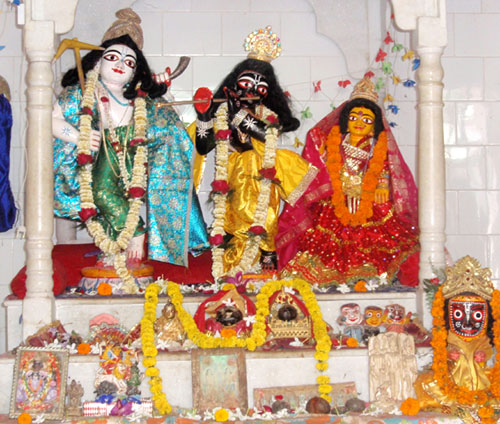
In the temple, Baladeva and Shri Shri Radha-Gopinatha are together on the throne. It is supposed that the Deity of Baladeva was installed later because according to transcendental mellow, Baladeva, Krishna and Radha cannot stay on the same throne. (In the image: Shri Shri Radha Gopinatha and in the left Shri Baladeva).

In front of the Temple, in a very attractive place among two Bakula trees and a Kadamba tree, is the tomb of Parameshvari Thakura, and above it is an altar with a Tulasi bush. It is said that only one flower a year comes out of the Kadamba tree. It is offered to the Deity. (In the wallpaper: Shri Gopinath, ISKCON Chowpatty, Mumbai, Kadamba flower).
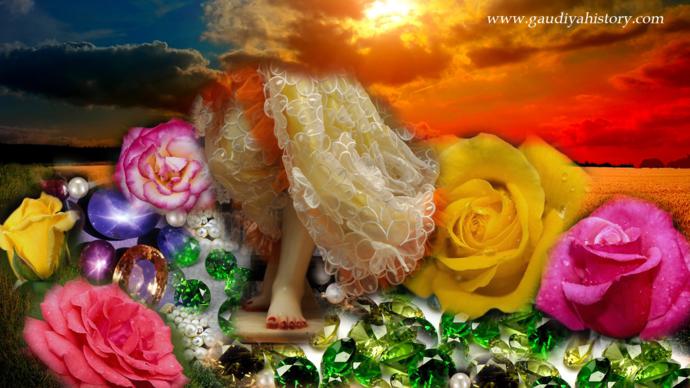
The first time that the Lord wished to go to Vrindavan from Nilachala, He came through Bengal, though He was eventually unsuccessful, He passed through Panihati, Kumarahatta, Kuliya, Ramakeli, Kanair Natshala, Shantipur, etc., before returning to Puri. When Nrisinghananda Brahmachari heard that Mahaprabhu was going to Vrindavan, he meditated on the Lord’s route, imagining a road of jewels as far as Kanair Natshala, when he realized that this was as far as the Lord would go, that he would not make it to Vrindavan this time. (In the wallpaper: Lotus Feet of Shri Gaura Chandra, ISKCON Chowpatty, Mumbai).
The first time that the Lord wished to go to Vrindavan from Nilachala, He came through Bengal, though He was eventually unsuccessful, He passed through Panihati, Kumarahatta, Kuliya, Ramakeli, Kanair Natshala, Shantipur, etc., before returning to Puri. When Nrisinghananda Brahmachari heard that Mahaprabhu was going to Vrindavan, he meditated on the Lord’s route, imagining a road of jewels as far as Kanair Natshala, when he realized that this was as far as the Lord would go, that he would not make it to Vrindavan this time. Thousands of people were accompanying the Lord at this time. When He arrived at Kanair Natshala, He remembered Sanatan Goswami’s advice,
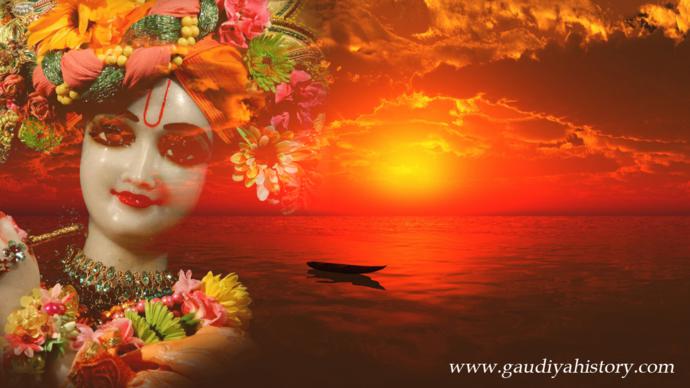
On His way back to Nilachala, Mahaprabhu stopped at Advaita’s house in Shantipur. This time He was accompanied by Balabhadra Bhattacharya and Damodar Pandit. When the Lord returned from Gaya, he also went as far as Kanair Natshala where he had a vision of Muralidhara Shri Krishna, who embraced him before he disappeared (Chaitanya Bhagavat 2.2.179-85). (In the wallpaper: Shri Muralidhara, ISKCON Manhattan, NYC, USA).
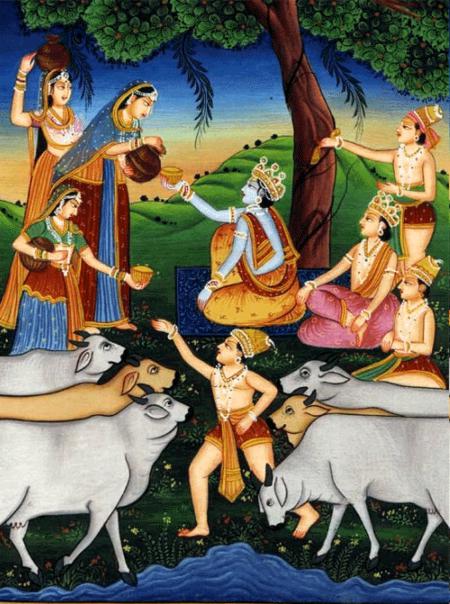
Parameshvara das, said to be the fifth gopala of Krishna lila, completely surrendered to the lotus feet of Nityananda. Anyone who remembers his name, Parameshvara dasa, will get love of Krishna very easily. (In the image: Wives of brahmanas are giving food to Krishna and His friends).
Shri Parameshvara dasa Thakura appeared in a family of physicians. His Shripat is at Atapur, which was on the Chanpandanga branch of the Howrah-Amrah rail line. Rail service on this line has been discontinued. Direct bus service is available from Howrah station; it is about a 2 hour journey from there. Atapur was previously known as Vishakhala. Shri Shri Radha-Govinda are still residing at his Shripat. In front of the Temple are two Bakul trees and in between them is Parameshvara Thakura's Samadhi mandira.
Shri Krishna das Kaviraj Goswami has written: "Parameshvara das, said to be the fifth gopala of Krishna lila, completely surrendered to the lotus feet of Nityananda. Anyone who remembers his name, Parameshvara dasa, will get love of Krishna very easily." [C.C. Adi 11.29]
Shri Kavi Karnapura Goswami has written: namnarjunah sakha prag yo dasah paramesvarah, "Parameshvara dasa Thakura was previously the cowherd friend of Shri Krishna named Arjuna."
Shri Vrindavana dasa Thakura has written:
nityananda jivan paramesvar das
jahar vigrahe nityananda vilasa
Krishna das paramesvar das dvi jon
gopabhave hoi hoi kore sarvakkon
"Parameshvara is the life of Lord Nityananda and his form (body) is the place of his pastimes. Krishna dasa and Paramesvara, being in the mood of cowherd boys, are always raising a commotion."
When Jahnava Mata attended the festival at Kheturi, Parameshvara accompanied her and went to Vrindavana with her as well. He installed Shri Shri Radha-Gopinatha at Atapur in accordance with the desire of Shri Jahnava Devi, who was personally present during the installation celebration.
paramesvari dasa thakura bandibo sabdhane
srigale loyar nam sankirtan sthane
One day, near Shri Rampur, at Akna Mahesh (the Shripat of Kamalakara Pippalai), there was a festival of nama-sankirtan going on within the Temple of Lord Jagannatha there. Parameshvara was present and was dancing in a completely God-intoxicated state. At that time some miscreants passed by there, and seeing a dead fox lying on the road, they picked it up and threw it into the midst of the sankirtan party. The highly exalted Vaishnavas present didn't feel any anger towards those ignorant fools, but Parameshvara felt sad to see the unfortunate dead fox, and so by his merciful glance he brought it back to life. Then that fox trotted out of the nat-mandir (kirtan hall) to the utter bewilderment of those miscreants, who then immediately fled from the spot.
Parameshvara dasa Thakura accompanied the Deity of Radharani that Shri Jahnava Devi sent to Vrindavana for Shri Govinda. He was the very dear servant of Shri Jahnava Mata. His disappearance is on the full moon day of the month of Vaishakha. On that day the khunti that he used in sankirtan is placed next to his samadhi mandir. Khunti – this is a symbol carried on a staff preceeding the kirtana party. Supposedly its history dates from the time when the Kazi gave his promise that no one would ever disturb the sankirtan parties again. This was an emblem of the Kazi, and its presence infront of the sankirtan party indicated that the party was sanctioned by the Kazi and thus no one should disturb them. Today it is decorated with eyes, tilak, flower garlands and cloths, and worshipped as a manifestation of Mahaprabhu Himself.
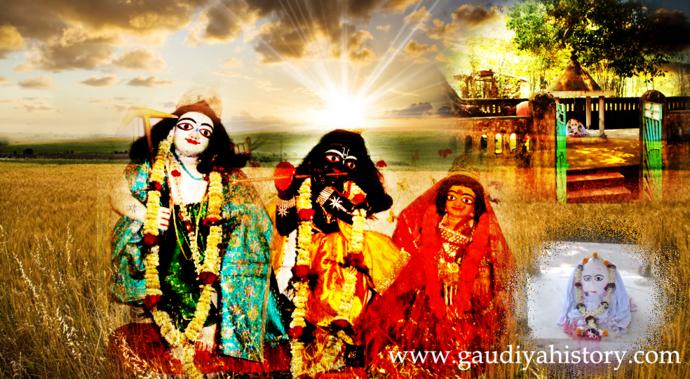
On that day the khunti that he used in sankirtan is placed next to his samadhi mandir. Khunti - this is a symbol carried on a staff preceeding the kirtana party. Supposedly its history dates from the time when the Kazi gave his promise that no one would ever disturb the sankirtan parties again. This was an emblem of the Kazi, and its presence infront of the sankirtan party indicated that the party was sanctioned by the Kazi and thus no one should disturb them. Today it is decorated with eyes, tilak, flower garlands and cloths, and worshipped as a manifestation of Mahaprabhu Himself. (In the wallpaper: Deities of Parameshvara Dasa Thakura and his samadhi).
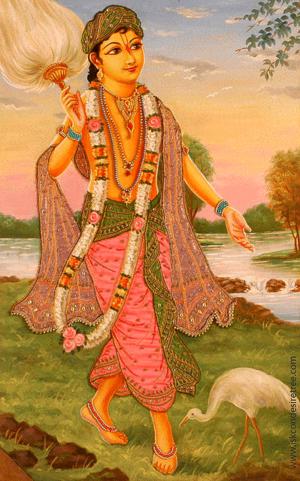
Parameshvara Dasa is one of the dvadasha gopalas named Arjuna. (In the image: Arjuna Gopa).